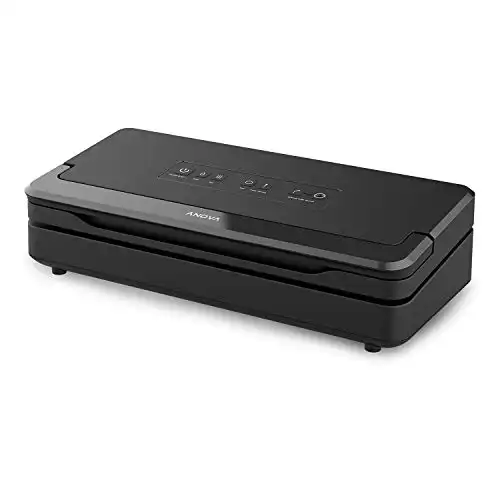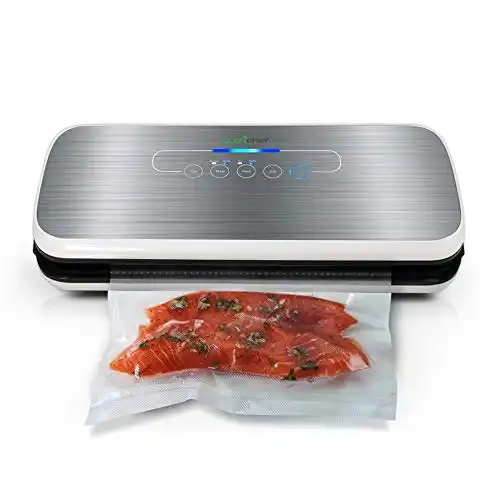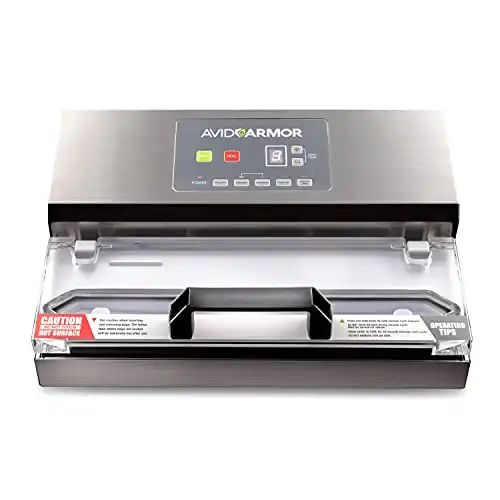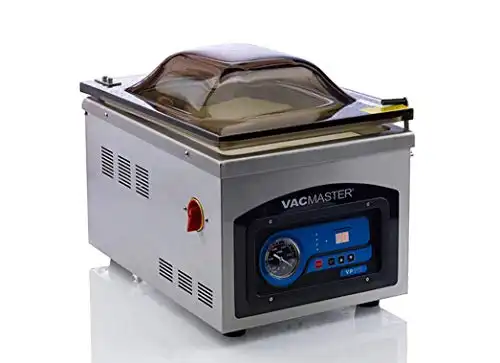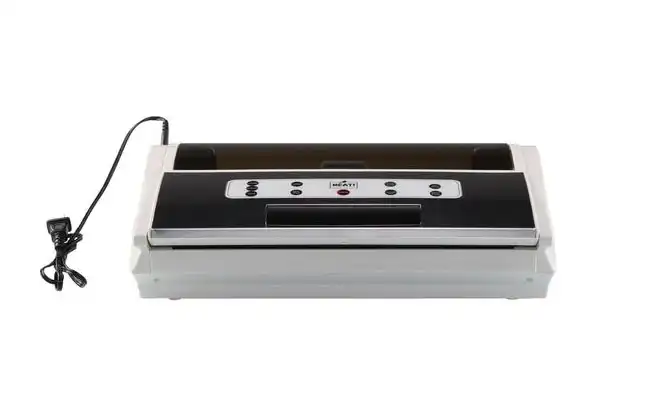The 9 Best Vacuum Sealers in 2024

With the price of meat where it is, you can’t afford to waste any.
If you find yourself tossing a lot of freezer-burned meat or struggling to cram stuff into your freezer, you need to start using a vacuum sealer.
After testing out lots of different brands sealing cuts of steak and ground beef I’ve found that the Meat! Your Maker Pro External Vacuum Sealer is the best vacuum sealer for most people with the best suction and most useful features.
The 9 Best Vacuum Sealers Reviewed
In my role creating recipes for Smoked BBQ Source I end up with a lot of leftover meat. I’ve found that vacuum sealing leftovers is the best way to avoid freezer burn and keep them fresh for the longest.
To find out who makes the best food vacuum sealers, I tested out a range of options including cheap handheld, external vacuum sealers, all the way up to expensive chamber vacuum sealers.
1. Best Overall – Meat! Pro External Vacuum Sealer
The Meat! Pro external vacuum sealer is a fantastic option if you’re willing to spend a little extra to get some more features that I think go a long way.
Meat! Your Maker is making a name for themselves by producing meat processing equipment, including grinders, stuffers, and meat slicers for the enthusiast home cook.
The vacuum sealer has a control panel that lets you easily adjust the seal time, the amount of suction, and if you want moist or dry vac.
There’s even a canning feature.
You also get a locking latch and a removable drip tray to keep everything nice and clean.
There is a vacuum bag roll compartment that is large enough to hold all different types and sizes of bag rolls. This allows you to pull the bags through the device and use the bag cutter to cut each bag to size and then start your vacuum sealing process.
None of the other sealers I tested had the ability to cut bags or a storage compartment for them either.
While this may not seem a big deal, I found it convenient to have everything together in one place, and not have to roll out the bags and try to cut them with scissors each time.
The sealing strip spans 14″
I also liked the flexibility of choosing how much air would be taken out of each bag. This would come in handy sealing delicate food such as baked goods, pastries, or fruit.
What we like:
- Control Panel – Different options available for more precise seal times and vacuum.
- Vacuum bag roll compartment – Great to have the bag storage and be able to cut bags to size as needed.
- Price – Reasonably priced for a vacuum sealer that gives you more options
What we don’t like:
Locking mechanism – Could use a little work and could see it wearing out over time.
The price point feels reasonable for this kind of sealer, and for those wanting something that’s a step up from the generic big box brands, I think this is the best vacuum sealer.
2. Best Budget – KitchenBoss G210
If you just want to do some occasional sealing, don’t want something quite a bit cheaper than the Meat!, the G210 from KitchenBoss is a great affordable option.
The KitchBoss has a sleek and compact design but at -70 Kpa suction, it is a powerful vacuum for its size. It’s also available in multiple colors, if matching your appliances is important to you.
It has an underneath compartment for storing the power cord, so it’s nicely tucked away for storage.
The KitchBoss has an inching mode that allows you to incrementally control the amount of vacuum, so it does not damage delicate foods such as berries or bread. It can vacuum seal dry or moist foods.
The device comes with 20 extra vacuum sealer bags and a nice pouch with a drawstring to store it in. You can use virtually any vacuum seal bag with it, and it works well.
What we like:
- Affordable – Cheaper than most options out there
- Vacuum power – Great vacuum power for the size
- Inching feature – Allows you to incrementally control the amount of vacuum so it does not damage delicate foods sucks as berries or bread
What we don’t like:
- Loud – It is pretty loud when vacuum sealing
I’ve been using the KitchenBoss for months without any issues. It’s a basic sealer that gets the job done at a good price.
3. Best Handheld – FoodSaver Handheld Vacuum sealer
This handheld sealer from FoodSaver is the little guy that packs a punch. This rechargeable cordless vacuum sealer is small enough to fit into your pocket but has the power to seal very well.
This sealer can seal up to 60 1-quart bags on a full charge. It’s lightweight and easy to use. It has a charging dock that makes recharging a breeze.
In my tests, I was impressed with how quickly the sealer charged and the speed at which it was able to seal. Simply line up the bottom of the sealer with the vacuum port on the bag, press the button on top and hold for 15-20 seconds.
The only drawback is you must use specific FoodSaver vacuum sealer bags that work with the sealer. The device does come with a pack of 4 bags to get started, but then you have to buy any additional ones.
What we like:
- Compact – Very small, can easily be stored and transported
- Affordable – Cheaper than most options out there
- Quick charge – Charges quickly and can seal 60 1 quart bags with one 24 hour charge
What we don’t like:
- Needs specific bags – You have to use specific foodsaver bags to use the device
You can pick one of these up for a fraction of the price you pay for most vacuum sealers. Sure, you won’t get anywhere near the level of features as the Meat! sealer, but if you just want to seal occasionally, it does the job.
4. Best Highend – Meat! Chamber Vacuum Sealer
This is the sealer I recommend if money isn’t an issue and you want a restaurant-grade food vacuum sealer at home.
The MEAT! Chamber Sealer with Oil-Less Pump is designed to extract air with precise control for the perfect seal.
The deep chamber can handle all kinds of meat, fish, and foods of all sizes. It has an easy-to-read LCD screen, and the Oil-Less pump minimizes the maintenance required.
The quick vac mode is easy to set. Just select the bag size, and it will do the rest. You can also manually control the seal and vacuum function. To start up, simply close the lid, and the vacuum sealer begins its process.
It can also seal liquids and has a marinate feature.
The device is big and heavy, so don’t plan on moving it around often. The chamber is deep enough to seal a lot of food, but if you need to seal something large like a whole chicken or roast, you will not have the space.
The chamber vacuum sealer also takes a little longer than most of the other sealers I’ve tested, but it does give you a great consistent seal every single time.
The lid is see-through, so you can see what’s going on inside and when the seal is complete. It also has a countdown feature to let you know the sealing is complete and the lid will open automatically, letting you know the same.
What we like:
- Nice design – Looks good and the LCD screen is a nice feature
- Great Seal – Gets a nice vacuum seal everytime
- Auto and manual settings – Nice to have flexibility
What we don’t like:
- Heavy – Bigger and bulkier compared to most sealers out there
- Price – A bit pricey. Would be great in a commercial setting like a restaurant.
Not only is the device heavy, but so is the price. If you are looking for a commercial-grade vacuum sealer this may be the one for you. However, for everyday use, you can find a lot of great options for much less money.
5. Another mid-range option – FoodSaver VS0150
The FoodSaver VS0150 sits between our top pick, the Meat! Pro and the budget KitchenBoss G210.
This vacuum sealer features a modern and slim design and offers vertical bag storage with a locking mechanism for keeping the device from opening. It offers two custom settings like the KitchenBoss, moist and dry. It also has a vacuum port.
In my tests, the suction power did not seem as strong as the KitchBoss, but it still did a decent job. There were several instances where I tried to vacuum seal something and had to redo it because the device didn’t pull enough air out of the bag.
Overall it’s an OK sealer, but for the price, I believe you can get better value elsewhere. It does come with a 3-year warranty which is great, and the FoodSaver brand is well known in the vacuum sealer industry.
What we like:
- Vertical storage – Locking mechanism to keep the device from opening
- Warranty – Nice 3-year warranty
What we don’t like:
- Weak vacuum – Not as strong as other vacuums, definitely lacking some power
- Price –Not really expensive, but better options around this price point
Other vacuum sealers worth considering
These are the vacuum sealers that narrowly missed out on our main selections. They are worth checking out, dpending on your requirements and if you manage to get one on special.
6. Anova Precision Vacuum Sealer Pro
The Anova Precision Vacuum Sealer Pro is easily one of the most convenient vacuum sealers on the market, offering powerful suction and several quality-of-life bells and whistles.
You get an area for bag storage, a bag cutter the option to add attachments for sealing jars. The sealing bar is 12″ long, which, although 2″ less than our top pick, is still decent.
Despite these features, the Anova Precision vacuum sealer is quite compact so it won’t take up too much space on your benchtop.
The controls are nice and simple to operate, and you get one roll of bags in the box.
Anova is one of the biggest brands in the Sous Vide space, so you know you are getting a quality product.
7. Vacuum Sealer By NutriChef
Where the V4400 is chock full of options and extras, the Vacuum Sealer By NutriChef is as simple as its name.
Light, portable, and just as simple to use as the V4400, the Vacuum Sealer comes five with reusable and waterproof vacuum bags, a complimentary roll of vacuum bags, and an air suction hose and wine stopper cork for resealing wine or oil bottles.
The sealing process is one-touch, and, like the V4400, the Vacuum Sealer has alternate modes for sealing dry or moist food. Unlike the V4400, however, these modes don’t activate automatically.
With dimensions of 14.1” x 6.0” x 3.0” and weighing in at 2.93lbs, the Vacuum Sealer is significantly smaller and lighter than the V4400, making it easy to store and carry, ideal for those who favor portability over bells and whistles.
What we like:
- It comes with complimentary reusable bags and a wine bottle resealer
- Compared to the V4400, the Vacuum Sealer is compact and lightweight
- The Vacuum Sealer has dry and moist food modes
- The ease of the one-touch activation system
What we don’t like:
- The dry and moist food modes don’t activate automatically
- The lack of adjustable sealing settings that would let the Vacuum Sealer work with any kind of vacuum bag
8. Avid Armor Vacuum Sealer Machine A100
A scaled-down commercial model for home, the Avid Armor Vacuum Sealer Machine A100 is a must-have for people who are using it for small business purposes or who just really need to vacuum seal a lot of food.
The double piston pump gives the machine some real vacuuming power, and the built-in cooling fan cuts down on the seal cycle time, meaning you can seal multiple bags at a faster rate. It also has a port on the side to attach a vacuum hose that you can use to seal jars and canisters.
One of the standout features of this machine is its impulse bag sealer mode, which seals the bags without the vacuuming step, allowing you to seal up fragile foods like chips, fruit, or bread.
This machine might lack a few of the more convenient functions, but it makes up for that in its robustness and the speed at which is can seal up a lot of food.
What we like:
- The cooling fan and double piston pump to speed up the vacuuming process
- The extra-wide 12” sealing bar for larger bags
- The fact that the Avid Armor Vacuum Sealer Machine A100 is the only machine on this list to come with spare parts
What we don’t like:
- The lack of a dry or moist food setting to help get an optimal seal for high liquid content food
- The fact that is weights 14.5lbs, making it less than easily portable
9. VacMaster VP215 Chamber Vacuum Sealer
Where external suction vacuum sealers have the benefits of being compact, lightweight, and easy to store, a chamber sealer will allow you to do things they just can’t.
If you regularly seal large amounts of food, need to vacuum seal liquids or liquid-rich foods, or you are a hunter looking to store larger cuts, then the VacMaster VP215 Chamber Vacuum Sealer is going to make your life much easier.
As we mention in the buying guide below, a chamber sealer keeps the air pressure inside and outside the storage bag equal until it is sealed. This means it won’t compress liquids, spraying them everywhere, or suck the liquid into the vacuum pump, potentially damaging the mechanism.
This ability to seal liquids allows you to make huge batches of sauce or soup and store them for up to five times longer than normal.
The VP215 uses 10” by 13” bags, perfect for larger cuts of meat or fish and ideal for hunters or anglers looking to store their catch.
Because it uses an oil pump, the VP215 is both powerful and needs little in the way of cooldown time, so you can seal up a lot of food without wasting time.
With dimensions of 20” x 14” x 15” and weighing in at 84lbs, the VP215 is neither light nor portable. However, if you need speed and power and don’t mind the fact that it’s a little bulky, this chamber sealer is the perfect choice.
What we like:
- The 10” by 13” bags are ideal for storing larger food items
- The heavy-duty oil pump makes the vacuuming process quick and cuts down on cooldown
- Unlike external vacuum sealers, the VP215 can be used to seal up liquids and moisture rich foods
What we don’t like:
- The VP215 is heavy, so if you are looking for a portable vacuum sealer, you might need to look elsewhere
- The Vacmaster pouches are sized to the machine and are proprietary
How do vacuum sealers work?
All vacuum sealers work by removing the air from a sealable plastic bag and then sealing it closed to prevent the air from rushing back in. Some vacuum sealers use proprietary types of plastic vacuum sealer bags that can be melted shut.

Some vacuum sealers create a vacuum through the use of a pressure chamber and some by using specially designed bags and an internal vacuum pump.
Most vacuum sealer bags are not reusable or can only be reused a limited number of times.
Some models have attachments that allow you to vacuum seal cans or other containers.
We’ll go over the pros and cons of the different styles of vacuum sealer later in this article.
What are the benefits of using a vacuum sealer?
Using a vacuum sealer removes oxygen from around the food that you are trying to preserve, significantly slowing down the rate at which your food oxidizes.
Food oxidization is a reaction between chemicals in the food and the oxygen in the air around them and is part of the process that causes fruit and vegetables to brown or spoil and meat to go rancid.
By cutting down on the amount of oxygen around your food, the spoiling process slows, and you can store food for much longer than if they had not been vacuum sealed.
Vacuum sealing also prevents food from losing additional moisture when frozen, which can help to prevent freezer burn, which is dehydration of the surface of frozen food caused by air exposure.
Finally, vacuum-sealed food takes up less space in your fridge and freezer, much like vacuum-sealed bedding in your wardrobe, freeing up some additional storage space.
Types of vacuum sealers
As we mentioned, vacuum sealers generally come in one of two kinds, chamber vacuum sealers and external suction vacuum sealers, each with their own pros and cons.
1. External suction vacuum sealers
External suction vacuum sealers work by clamping down on a specially designed vacuum bag, that has been filled with food, and then suctioning the air out with a pump before heat sealing the bag.
These are the best option for most people as you get more features and better suction than hand held, without the price of chamber. Our top pick the Meat! Pro is an external suction sealer.

Not all external suction sealers can be used to seal liquids or very moist food, as this gets sucked into the pump mechanism, so be sure to check if this feature is important to you.
Pros
- External suction vacuum sealers were designed for convenient home use, so they tend to be smaller, lighter, and less bulky than chamber sealers
- External suction sealers are comparatively inexpensive
- Some models can be used to seal proprietary canisters or jars in addition to vacuum sealer bags
Cons
- Most external suction sealers cannot be used to seal liquids or food with high liquid content
- Because of their low vacuum strength, external suction sealers take much longer than chamber sealers to remove the air from a container, making them less practical if you find yourself vacuum sealing a lot of food on a regular basis.
2. Chamber vacuum sealers
Until recently, chamber vacuum sealers tended to be too bulky to be used anywhere other than in commercial settings.
However, advancements in the vacuum creation technology that they use have allowed chamber vacuum sealers like the Meat! Chamber Vacuum Sealer to become small enough to be used in the home.

Chamber vacuum sealers work by removing the air from a pressure chamber in which a sealable bag of food has been placed.
Because the air pressure inside and outside of the container remains the same, the bag does not deform, and the food is not disturbed, allowing you to vacuum seal liquids or very moist food.
Pros
- Because of the use of a pressure chamber, chamber vacuum sealers can be used to vacuum seal liquids and food with a high liquid content
- Works very quickly and is very effective if you find yourself vacuum sealing large amounts of food
- Some models come with additional features that allow for the vacuum sealing of other containers and the sealing of fragile foods, like chips.
Cons
- As a scaled-down industrial applicant, most chamber vacuum sealers tend to be bulky, heavy, and expensive.
3. Handheld Vacuum Sealers
Handheld vacuum sealers like the FoodSaver are a smaller, lightweight, battery-powered option that uses a combination of a compact handset with a pump in it and a special ziplock bag with a non-return valve mounted on it.

Smaller food items can be placed in the bag and then sealed by pushing the pump handset against the non-return valve and sucking out the air.
As you might expect from a handheld option, these small, portable sealers don’t have a lot of power and can’t be used to seal liquids. They work great with smaller perishable food items like cheese or deli meats, but will generally struggle with anything larger. Their main selling point it their portability.
Pros
- Most handhelds are small, light and battery powered, which means you can carry your vacuum sealer around with you in a bag or backpack
- Compared to chamber or external pump sealers, handhelds are reasonably inexpensive and less complicated to use
- The non-return valve ziplock bags are generally reusable and washable
Cons
- Handheld sealers can’t be used to seal larger food items or liquids
- The vacuum pump uses a fair amount of battery power, which means maintaining power can be a problem if you are sealing a lot of food
What to look for in a vacuum sealer
The best way to find a vacuum sealer that you’ll be happy to use regularly is to invest in one that matches up to your needs. To help you with that, we’ve put together some key utility features you’ll want to look out for when buying a vacuum sealer.
Size
If you are looking for a vacuum sealer for sealing up leftovers and storing them in your fridge freezer, then an external suction sealer should work fine.
The two measurements you’ll need to look at are the length of the sealing bar, which is the section that melts the vacuum bag closed, and the volume of the vacuum bags themselves, especially if the machine you’re looking at uses proprietary bags.
One of the things I liked about the Meat! was the option to use various sized bags.

However, if you’re looking to seal up large quantities of food, or bulky foods like ribs, or joins of meat, then you’ll probably be better off investing in a chamber sealer, as they are faster and can vacuum seal large items.
When buying a chamber sealer, remember to check the width of the chamber, which tends to range from 8″ to 13″, and if the model you are looking at has a removable pressure plate or a domed cover to increase its depth.
Manual or auto?
Most vacuum sealers made for the home market automatically seal the vacuum bag based on a specific parameter. For external suction sealers, it is usually a pre-set time after the sealer has been activated, which is called its ” Vacuum Cycle.”
Most chamber sealers and some higher-end external suction sealers use the pressure in the bag or chamber as their cue to seal the bag.
Some vacuum sealers require the user to control when the sealing should begin manually. If you are looking for the greatest ease of use in your vacuum sealer, it’s best to invest in one with automatic sealing controls.
Seal Cycle
The seal cycle is how long you’ll have to leave your vacuum sealer after each use to allow it to cool down and be ready to operate again. Trying to seal another bag before the seal cycle completes could result in a poor seal or even irreparable damage to the sealer’s heating element.
If you find yourself needing to store a large quantity of food in small individual amounts, it’s probably worth investing in a chamber sealer as they tend to have a faster seal cycle.
Portability/storage
As we mentioned earlier, chamber sealers tend to be bulky and heavy. If you are looking for a vacuum sealer for a small kitchen, an RV, or even to take to a cookout with you, then an external suction sealer represents a lighter, more portable option.
Extra features
Once you’ve picked the basic outline of what you want from a vacuum sealer, it’s time to think about the bells and whistles.
Standard extra features for vacuum sealers include an external vacuum system that can be used to vacuum cans, jars, and canisters, adjustable seal settings that allow you to use different kinds of vacuum pouches and a bag cutter that will enable you to create custom-sized pouches that are less expensive than pouch packets.
How much benefit you get for those extra features depends on your individual vacuum sealing needs.
Foods that should not be vacuum sealed
While a vacuum sealer can be used to extend the life of steak leftovers, certain foods do not react well to a vacuum.
If you are sealing liquids using a chamber sealer, make sure the liquid is properly cooled to at least room temperature. Hot liquids exposed to low air pressure will start to boil, potentially exploding and at the least, making a mess of your machine.
Raw mushrooms, garlic, freshly cooked or steamed vegetables, and soft cheeses like blue cheese, brie, camembert, and ricotta all contain anaerobic bacteria. These bacteria do not need air to thrive and will multiply quickly in a vacuum-sealed bag, representing a potential risk to your health.
Additionally, vegetables from the Cruciferae or Brassicaceae family release a gas that will cause them to spoil even when vacuum sealed. To store these vegetables in a vacuum pouch, you first need to blanch them and dry them.
Some common Cruciferae and Brassicaceae vegetables are:
- arugula
- bok choy
- broccoli
- Brussels sprouts
- cabbage
- cauliflower
- kale
- radishes
- turnips
Wrapping it up
It’s time to say no to freezer burn and start using a vacuum sealer. You can even couple it with your sous-vide machine and go straight from the freezer to the table.
For most people, we recommend the Meat! Your Maker Pro External Vacuum Sealer thanks to its simple operation and build quality.
If you’ve got a favorite model of vacuum sealer that had done well by you, or any vacuum sealing trade secrets you’d like to share, we’d love to hear about them in the comments below.













